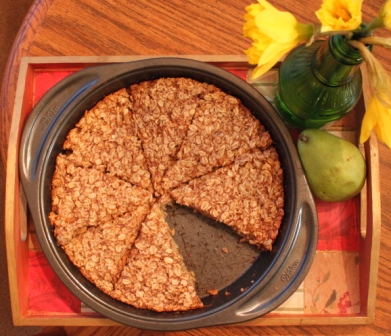What would you do if you were told you had anaphylactic food allergies and were unable to use the steroids that could save your life? What would you do if after years of living in fear, you were told you were given a false diagnosis?
Please welcome Julie Moore of Natural and Free and Fibro, Fit and Fab! Her story is unbelievable! I admire Julie’s incredibly positive attitude and passion to use her experience to help others.
******************************************************************
Almost 10 years ago now, I had what I thought was an allergic reaction to food. I’d never had an allergic reaction to food (I had seasonal allergies, skin sensitivities and that sort of thing, though). I thought for sure that’s what it HAD to be, because I’d just eaten. The reaction involved what I thought was anaphylaxis.
I will admit that I panicked. I could talk. I could swallow, but my throat felt tight. I felt like I couldn’t breathe, and I felt sick…and my mind instantly went to “I’m going to die! Get me to the doctor NOW!” The more I panicked, the worse it got, so off to the doctor I went.
At the Urgent Care, they asked me if I had a history of asthma. I told them no, but it did run in my family. They nodded, sent the doc in, and had him look down my throat. He asked me what I thought caused it, and I told him that we’d just eaten at a Chinese place where I’d had some seafood and nuts. I had no history of food allergy personally (my brother is allergic to casein and egg whites, my mother to fish). He just kinda took it all in, and though he thought everything looked ok, gave me a steroid shot. At this point I felt a little better, but not completely. He assured me I’d be fine. He then gave me some Prednisone pills and sent me on my way. He told me to avoid the possible offensive foods and to return if it happened again.
I was starting to feel pretty confident then. I figured it would be easy enough to avoid nuts (tree nuts and peanuts) and seafood. I would be just fine, I told myself…But I wasn’t.
A few days into the Prednisone, I had another “reaction”. I went back to the Urgent Care, this time telling them that I had difficulty breathing while on Prednisone. You can imagine how much they hated that. For those of you who don’t know, steroids are how they treat severe allergic reactions when things like Benadryl don’t work. If I was allergic to steroids, I had no way to treat a severe reaction, which is what I thought had brought me to the hospital in the first place! This was very not good.
The doctor there told me that I must have allergy testing done. She told me that if I indeed had food allergies and could not have steroids and had an anaphylactic reaction, that was the end of me. That, needless to say, freaked me out. No one wants to hear they could die the next time they eat. I quickly agreed to the scratch tests, and they were scheduled for about a week or so later, to make sure the Prednisone would be out of my system.
Until that appointment I was a mess. I was afraid to eat too many things since I couldn’t take anything if I had a reaction. I’m sure I drove my family nuts, too, worrying about everything. It was no way to live, that’s for sure.
Well, the day of the appointment came. I was scared, but also relieved in a way. I would finally know what the problem was! I could live life “normally” again…or so I thought.
I won’t get into it all, but the allergist that conducted my test was far from professional. For one, his nurse used a scented marker to mark the spots for testing (a HUGE no-no). For two, she tested on the most sensitive areas of my back that are most likely to show false positives (I found that out years later, but I’ll get to that in a moment). For three, he did not wait the full 15 minutes before checking the results which can lead to misdiagnosis. That’s not the whole of it, but that’s enough to give you the idea. Anyway, since I was none the wiser, I took the diagnosis at the doctor’s word, not willing to question it, though there were warning flags I brushed aside.
The results, tainted as they may have been? I was allergic to soy, lobster and peanuts. I was to avoid all soy, all fish and seafood and all forms of tree nuts (because of possible cross-contamination) and peanuts. I was sent home with a script for an epi-pen, told to take 2 Benadryl and a Zantac at the first sign of any tickle in my throat after eating or I was dead. Yes, he really did say that. In the same breath he told me not to use the epi-pen unless I absolutely had to (and which he almost didn’t prescribe me). I gulped hard, but figured I could do this. I mean, how hard could it be? I would soon find out, it was very hard.
Oh, it wasn’t avoiding the fish/seafood and peanuts/tree nuts that was difficult. It was the soy. When I checked my cupboards and my labels I was shocked. It was everywhere! It was in my bread, my ice cream, my yogurt, my cereal – I wanted to cry! I had to restock, and that first trip to the store was a nightmare, let me tell you!
I tried to eat pre-made stuff still, but more often than not I’d have a “reaction” to something. I’d get angry then look at the labels. If there was no obvious soy name that I’d happened to miss, I would go online to find out which ingredient was linked to soy, which drove me nuts. I was angry that companies didn’t have to say it contained soy if they used just soybean oil or soy lecithin or used another name for soy. I hated that I had to decode everything. It just didn’t seem right or fair.
I will admit that I was a bit paranoid around food. That doctor had me absolutely terrified to try any new food or any food for that matter. Eating was something I did only when I had to, and then I’d watch the clock for 15 minutes to see if I’d have a reaction or if I’d be just fine. It was no way to live, but it was where I was at the time.
Fast forward to a few years later when we moved, and I got a new doctor. He figured out that I had asthma, but it was exercise-induced. I told him about the reaction I’d had, and he said it sounded like more of an asthma attack than anaphylaxis. He wanted to re-test me for allergies via blood test. I was a bit skeptical, but agreed to the test.
The results? No food allergies. I thought he was insane. I asked him how that could be. He said he didn’t know. He referred me to an allergist to have another skin prick test done to be on the safe side, which I agreed to.
The allergist I saw was an hour and a half away from where I lived, but let me tell you, he was worth going to! He is an amazing man, and very good at his job, not to mention his staff was beyond wonderful.
When I told them what I’d gone through, they told me that the doctor had acted unprofessionally, and I would not get that kind of treatment there. They then proceeded to do their tests. It turned up that I indeed have exercise-induced asthma, and that I did NOT have any food allergies (though I was allergic to ragweed on a minor scale). He believed that my reaction was probably an asthma attack coupled with severe heartburn due to my weight and diet that simulated the feeling of anaphylaxis. To be 100% sure though, I had to go through a food challenge where you eat the food you might have reacted to and see if/how you react.
The results of the challenge? No food allergies. I was free of my burden! I could go back to eating how I used to! No more living in fear of every bite! No more watching the clock for those dreaded 15 minutes after eating to see if I’d need to take some meds!
Fast forward again to August of 2012. I’d been having some issues with chronic fatigue, wide-spread pain, mood swings, etc. and my doctor diagnosed me with Fibromyalgia. I didn’t know much about it, but I did some research and found out that eating whole, natural foods and avoiding food triggers would help. Ironically, besides processed food, one of my triggers is soy! I’m glad I learned years ago how to identify it, because it’s making this leg of my life’s journey a whole lot easier.
It’s taken me awhile to get to this point, but here it is: Allergies or even chronic conditions like Fibromyalgia are not the end-all. You learn through them, you find new friends and allies to help you through them and vice versa, and you learn that quality of life is not defined by your position in life. Quality of life is defined by your perspective. I choose daily to be grateful for what I have, for the moments (though they can be fleeting) that I am pain-free, and for the unique opportunity I have to help those like you who suffer from these things and more.
I wish you all the best on your journeys in life! If I can be of help to you in any way, be it to talk or just listen, feel free to contact me at any time.
******************************************************************
Julie Moore is a wife (married for 12 1/2 years) and mother of 3 (ages 10, 8 and 2). She is also the author of Natural and Free, which provides allergy-friendly recipes and helpful information for those who suffer from or care for those suffering from one to all of the top 8 allergens. She also authors Fibro, Fit and Fab! where she chronicles her journey to becoming fit and fabulous despite having Fibromyalgia. Posts about her life in general and topics she is passionate about pop up there, too.

 November 2nd, 2012
November 2nd, 2012  Nancy
Nancy 
 Posted in
Posted in 


 me mother of two. One with eczema, food allergies, and asthma. One with mild eczema. She blogs about her family’s battles with allergies, eczema, and asthma at
me mother of two. One with eczema, food allergies, and asthma. One with mild eczema. She blogs about her family’s battles with allergies, eczema, and asthma at 



